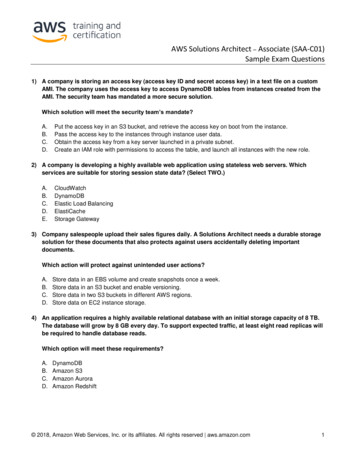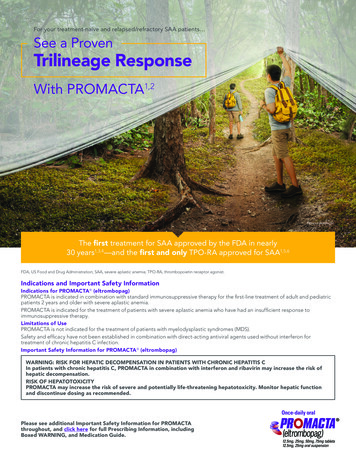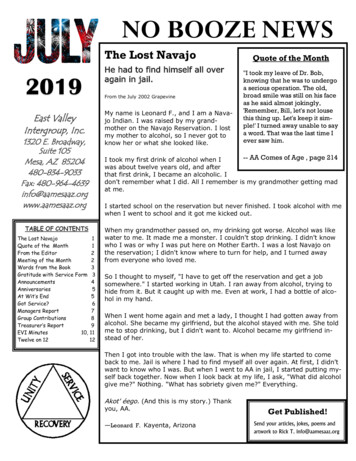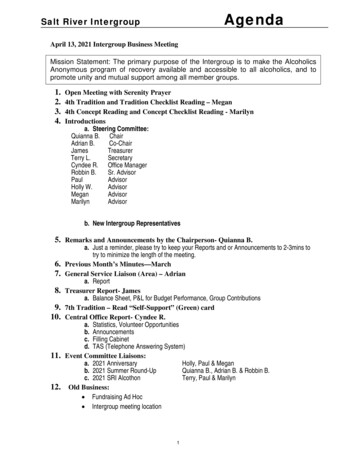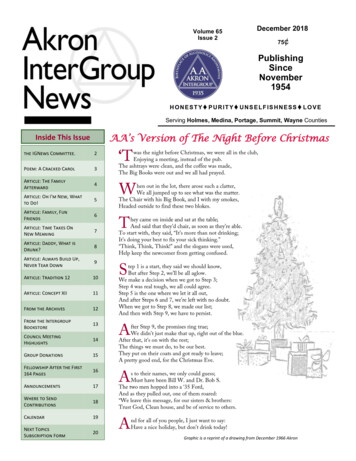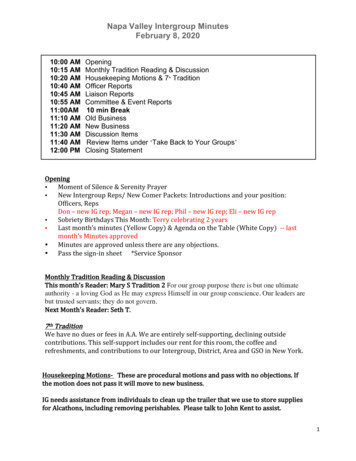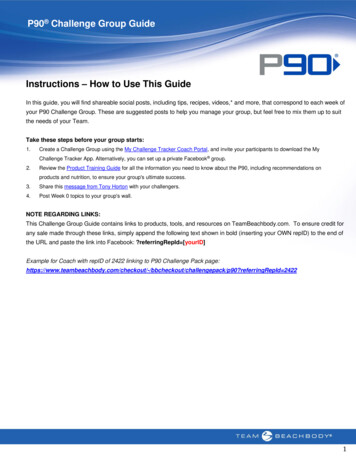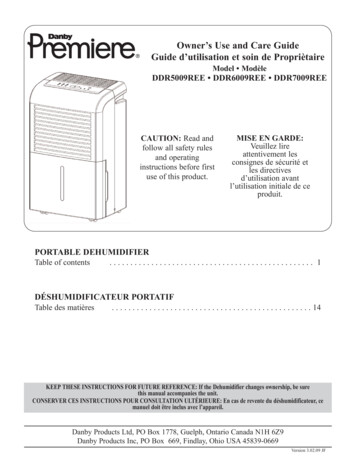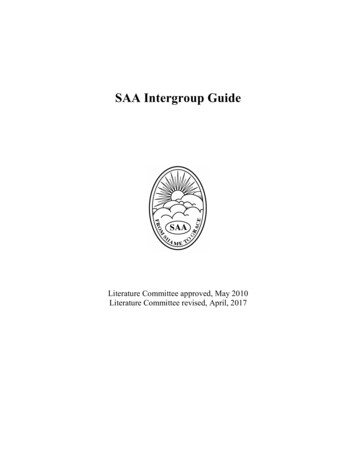
Transcription
SAA Intergroup GuideLiterature Committee approved, May 2010Literature Committee revised, April, 2017
Table of ContentsTable of Contents . 2The Twelve Traditions of Sex Addicts Anonymous. 5Purpose of the Guide . 6Intergroups . 6“Intergroup” Defined . 6Purpose of the Intergroup. 6Forming an Intergroup . 7Contacting Groups and Members to Form an Intergroup . 7Representatives within an Intergroup . 8Registration of the Intergroup with ISO . 8Guidelines/Bylaws for the Administration of an Intergroup . 9Guidelines for New or Small Intergroups . 9Guidelines for Larger or Established Intergroups . 9Trusted Servant Positions . 9Chair. 10Vice Chair . 10Secretary . 10Treasurer . 10Other Trusted Servant Considerations . 10Committees . 11Intergroup Meetings . 12Intergroup Meeting Locations. 13Example of First Meeting Agenda . 13Maintenance of Intergroup Functions . 14Finances . 14Budget and Reserves . 14Opening a Bank Account (USA) . 15Operating Financially within the Law (USA) . 15Nonprofit Status or Tax-Exempt Status (USA) . 16Fundraising . 16Insurance . 17Internet, Email, Telephone, and Mailbox Options . 17SAA Intergroup Guide2
Participation in the Larger Fellowship . 18Submitting Notices of Events to ISO . 18Representation in Fellowship-Wide Matters . 18Mandated Reporting. 18Communication Between Groups . 19Web-Based Communications. 19Newsletter . 19Inreach and Developmental Activities . 20Promoting Safe, Sober, and Welcoming Meetings . 20Workshops, Retreats and Speaker Lists . 20ICC Website . 21Outreach . 21Advertising Campaigns . 21Websites . 22Telephone Information Lines . 23Responses to Media Requests . 24Sustaining an Intergroup . 24Intergroup-Sponsored Outer Circle Activities . 24Joint and/or Open Speaker Meetings . 25Ways to Enliven an Intergroup . 25Creating Freshness . 25Reprioritizing and Streamlining Efforts. 26Sharing Experience with Other Intergroups . 27Performing an Intergroup Group Inventory . 27Avoiding Complications with Outside Issues . 28Affiliations and Autonomy . 28Cooperating with Other S-Groups . 29Appendices . 30Appendix A. Small to Medium Intergroup with no Written Guidelines or SimpleGuidance Document. 31Appendix B. Medium Intergroup and Bylaws, Starting with their Coverage . 33Appendix C. Medium Intergroup and Bylaws, Starting with their Purpose . 38Appendix D. Large Intergroup with Extensive Bylaws . 42Appendix E. Intergroup Literature Committee . 49Intergroup Literature Committee Description . 49SAA Intergroup Guide3
Experience of an Intergroup Literature Chair . 49Sample Job Description for Intergroup Literature Committee Chairperson . 50Appendix F. Guidelines for Cooperation with Other S-Recovery Fellowships . 51International Service Organization of Sex Addicts Anonymous, Inc.PO Box 70949Houston, TX 77270info@saa-recovery.orgUS/Canada: 800-477-8191Elsewhere: 713-869-4902SAA Intergroup Guide4
The Twelve Traditions of Sex Addicts AnonymousAt every level of our service structure we are guided by the Twelve Traditions of SAA,as adapted from the Twelve Traditions of Alcoholics Anonymous. Just as the Steps teachus the principles necessary for healthy individual recovery, the Traditions embody thespiritual principles for the healthy functioning of our groups. [Sex Addicts Anonymous,p. 77, Third Edition.]1. Our common welfare should come first; personal recovery depends upon SAA unity.2. For our group purpose there is but one ultimate authority—a loving God as expressedin our group conscience. Our leaders are but trusted servants; they do not govern.3. The only requirement for SAA membership is a desire to stop addictive sexualbehavior.4. Each group should be autonomous except in matters affecting other groups or SAA asa whole.5. Each group has but one primary purpose—to carry its message to the addict who stillsuffers.6. An SAA group ought never endorse, finance or lend the SAA name to any relatedfacility or outside enterprise, lest problems of money, property, and prestige divert usfrom our primary purpose.7. Every SAA group ought to be fully self-supporting, declining outside contributions.8. Sex Addicts Anonymous should remain forever nonprofessional, but our servicecenters may employ special workers.9. SAA, as such, ought never be organized, but we may create service boards orcommittees directly responsible to those they serve.10. Sex Addicts Anonymous has no opinion on outside issues; hence the SAA nameought never be drawn into public controversy.11. Our public relations policy is based on attraction rather than promotion; we needalways maintain personal anonymity at the level of press, radio, TV and films.12. Anonymity is the spiritual foundation of all our traditions, ever reminding us to placeprinciples before personalities.SAA Intergroup Guide5
Purpose of the GuideThis guide has been designed to give SAA members an overview of why and howintergroups have been formed within our fellowship, practical suggestions based onfellowship experience, and points of contact for additional information. We hope thisinformation will be useful both to those starting new intergroups as well as to existingintergroups looking for ways to better serve their local areas. The existence of anintergroup follows the tenets of our Ninth Tradition: “SAA, as such, ought never beorganized, but we may create service boards or committees directly responsible to thosethey serve.”The contents of this guide are only suggestions, not rules. However, it is urged that themembers of intergroups keep in mind the Fourth Tradition, which states that “Each groupshould be autonomous except in matters affecting other groups or SAA as a whole.”Intergroups should undertake no activity that would be harmful to another SAA group orhinder the recovery of its members.Intergroups“Intergroup” DefinedAn intergroup is a group of SAA members representing autonomous SAA groups thathave some commonality or desire for joint activity. The commonality may be ageographic area, a specific type of meeting (such as a group of telemeetings), or someother reason. The intergroup then meets regularly to conduct business for the benefit ofits member groups. Autonomous groups choose whether to form and participate in anintergroup or not. As stated in Sex Addicts Anonymous, “When several meetingscoordinate their activities, they create an intergroup, which is a board or committeethrough which these groups provide services” [p. 91, Third Edition]. An intergroup, onceformed, becomes its own organizational entity. Intergroups exist to serve their membergroups; they do not preside over them. Intergroups are encouraged to register with theISO. Intergroups may also participate in area or regional caucuses in the area or region inwhich they are registered.Purpose of the IntergroupBecause it can pool resources, an intergroup can be effective in providing services andsupport to its constituent groups and achieve greater outreach effectiveness than theSAA Intergroup Guide6
individual groups could alone. Intergroups might typically provide the followingservices: Funding and coordinating the use of a jointly held post office box and arrangingfor mail distribution to the groupsFunding and coordinating a jointly operated telephone response line, includingcoordinating volunteers to return phone calls to the lineFunding and coordinating special inreach and outreach projectsDeveloping and maintaining an intergroup websiteMaintaining and publishing meeting listsForming an IntergroupContacting Groups and Members to Form an IntergroupOnce the decision to start a new intergroup has been made, members may feel uncertainabout how to proceed. Several initial steps will help yield a smooth launch to a newintergroup.First, on the local group level, we recommend determining which of the local groupswant to be part of an intergroup. Asking for a local group conscience on this question willgive those members interested in starting an intergroup a gauge of local support for thiseffort.Next, local groups need to determine the geographical scope of the intergroup, if relevant.While the local groups may ultimately decide the scope, it may be helpful to contact theISO for additional resources.Once the initial scope is determined, the next step is to contact other groups within therange of the developing intergroup. Groups can be contacted either in person, throughattending meetings, by phone or by email. We recommend providing your own contactinformation to those you approach and explaining the scope of the proposed intergroup.Contacts are then typically asked to find out if their groups are willing to participate inthe intergroup effort.We recommend following up with your contacts after two to three weeks. Do not bediscouraged if some contacts or groups are less enthusiastic about the idea ofparticipating in an intergroup than others. This early exploratory stage can yieldimportant information about the practical level of activity for the proposed intergroup.Most groups are reasonably willing to participate if several persons spearhead the effort.Once there are enough groups agreeing to participate, founding members can review theirassumptions about the relevant geographic scope and proceed.Participating SAA groups are typically asked to assign a representative or two to attendintergroup meetings. The representatives’ contact information is compiled and usuallySAA Intergroup Guide7
sent to a central location—probably an existing group’s or an individual’s email address,phone number, or mailing address. (At this point, it is likely too early for the intergroupto have its own mailbox, website, central email, or other email address, sincerepresentatives will not have yet agreed to the expenditures for these items.)A central location should be chosen for the initial intergroup meeting. In preparation forthe first meeting, we recommend sending out the location to the groups’ representativesand requesting agenda items. Finding out how many representatives expect to attend willensure enough materials are prepared for participants. A tentative agenda should be sentout prior to the first intergroup meeting to support initial attendance and to fosterdiscussion at local group meetings. An agenda sent out in advance can help keep thescheduled event fresh in representatives’ minds and provide focus for the upcomingmeeting. We recommend following up with a reminder call or email a few days prior tothe meeting.Lastly, we recommend that primary organizers make one or more contact phone numbersavailable on the day of the meeting (such as personal cell phone numbers) so that firsttime attendees can call for directions or report delays.Following these suggestions can help founding members prepare for a smooth andproductive initial intergroup meeting.Representatives within an IntergroupTypically, an intergroup’s business is accomplished through the participation of itsmembers, each member representing a specific SAA group. These representatives are thevoting members of the intergroup. One vote per SAA group helps ensure that onemeeting isn’t overrepresented even if one group is more active in intergroup matters thanother groups. Officer positions in the intergroup such as Chair, Vice Chair, Secretary, andTreasurer are rotated among representatives so that each group can serve in differentcapacities within the intergroup over time.Registration of the Intergroup with ISOOnce formed, an intergroup should register with the ISO. The registration form can eitherbe taken from the Group Guide or requested from the ISO office. Two representativesfrom different groups need to sign the intergroup registration form and then mail it to theISO at P.O. Box 70949, Houston, TX 77270.After the ISO receives the registration, the intergroup will receive a group number for usein future correspondence and tracking with the ISO. Should any contact changes occurwith your intergroup, be sure to inform the ISO.SAA Intergroup Guide8
Guidelines/Bylaws for the Administration of an IntergroupGuidelines for New or Small IntergroupsEvery new intergroup needs to decide how to conduct its business. If the new or smallintergroup does not yet have guidelines in place, we recommend keeping written minutesof intergroup meetings. These minutes can be used to record decisions, to report back tothe member groups about the intergroup’s revenue and expenditures, and to record issuesrequiring member group conscience decisions, which would then be reported at the nextintergroup meeting. Eventually, the new or small intergroup will determine whether thereis value in developing written guidelines or bylaws to provide continuity of service asintergroup representatives and board members change over time.Guidelines for Larger or Established IntergroupsA larger intergroup may have written rules and procedures, often in a legal format calledbylaws, which are adopted to facilitate the intergroup’s smooth, ongoing functioning.These procedures or bylaws typically consist of articles specifying the intergroup’s scopeand purposes and describing how it conducts its business. The bylaws typically do notdescribe the minutiae of detailed activities or programs. Rather, they document theadministrative processes that the intergroup’s members have agreed upon. Over time, asnew members take on intergroup tasks and old members rotate off, the bylaws ensureintergroup continuity. The appendices contain examples of bylaws and guidelines fromseveral intergroups.Each intergroup decides whether or not to adopt formal bylaws. While some intergroupsexist for a long time before formally adopting bylaws, others have made it a priority toestablish bylaws early on. We suggest that any intergroup writing new bylaws or revisingexisting bylaws review what other intergroups have developed. Adapting what hasworked for other intergroups can help those developing bylaws avoid the twin problemsof either cumbersome or inadequate bylaws. When developing bylaws, keeping it simpleis likely to yield successful results.Once in place, bylaws should not be revised frequently. While it is advantageous toperiodically take an intergroup inventory and then make changes based on the needs ofthe constituent groups, bylaws are meant to support an intergroup’s ongoing functioning,not be its primary development activity. With careful, succinct construction, bylaws willallow intergroups to focus most of their efforts on service to their groups, members, andmost importantly, the
intergroup or not. As stated in Sex Addicts Anonymous, “When several meetings coordinate their activities, they create an intergroup, which is a board or committee through which these groups provide services” [p. 91, Third Edition]. An intergroup, once formed, becomes its own organ
